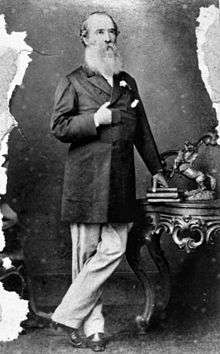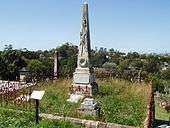Maurice Charles O'Connell (Australian politician)
| The Hon Sir Maurice O'Connell | |
|---|---|
 Maurice Charles O'Connell in 1860 | |
| President of the Queensland Legislative Council | |
|
In office 27 August 1860 – 23 March 1879 | |
| Preceded by | Sir Charles Nicholson |
| Succeeded by | Sir Joshua Peter Bell |
| Member of the New South Wales Legislative Council | |
|
In office 1 August 1845 – 20 June 1848 | |
| Member of the Queensland Legislative Council | |
|
In office 1 May 1860 – 23 March 1879 | |
| Personal details | |
| Born |
Maurice Charles O'Connell 13 January 1812 Sydney, Australia |
| Died |
23 March 1879 (aged 67) Parliament House, Brisbane, Australia |
| Resting place | Toowong Cemetery |
| Nationality | Australian |
| Spouse(s) | Eliza Emiline Le Geyt (m.1835 d.1903) |
| Relations | Sir Maurice O'Connell (father), Mary Bligh (mother), William Bligh (grandfather), William O'Connell (nephew) |
| Occupation | Army officer |
| Known for | President of the Queensland Legislative Council |
| Religion | Church of England |
Maurice Charles O'Connell (13 January 1812 – 23 March 1879)[1] , was a Queensland pioneer and president of the Queensland Legislative Council.
Early life
O'Connell was born at Sydney in 1812. His father was Sir Maurice Charles O'Connell, his mother was Mary (née Bligh, formerly Putland) a daughter of Governor William Bligh. He was educated at the high school, Edinburgh; Dublin and Paris.[2][3]
Army career
O'Connell entered the army as an ensign at 16 and joined the 73rd Regiment at Gibraltar.[2] In 1835 he volunteered for foreign service with the British Legion as colonel which he himself had raised in the county of Cork and other parts of Munster in Spain, to sustain the cause of the Spanish Queen and constitution against the insurgent Carlists.[2] Later on he became Deputy Adjutant-General, and ultimately succeeded Sir De Lacy Evans as general of brigade in command of the now British Auxiliary Legion in Spain. The Legion was disbanded in 1837, Sir Maurice O'Connell being rewarded for his services by having the knighthood of several Spanish orders conferred upon him.[2]
On his return to England he was appointed to the 51st Regiment, and afterwards becoming captain in the 28th, was appointed military secretary on the staff of his father in New South Wales in 1835. When the 28th was recalled to England, Sir Maurice sold out, and engaged in pastoral pursuits.[2] He afterwards resigned from the army and took up land.


Political career
O'Connell was elected a member of the New South Wales Legislative Council in August 1845 for the electoral district of Port Phillip.[4] He was appointed commissioner of crown lands for the Burnett district in 1848, became government resident at Port Curtis (now Gladstone) in 1854, and held this position until 1860.
He was nominated as one of the original members of the Queensland Legislative Council in 1860,[5] was a minister without portfolio in the first ministry under Herbert, and introduced in July of that year a bill to provide for primary education in Queensland. Shortly afterwards he was elected president of the legislative council and retained this position until his death.
In 1863, O'Connell was one of the founders and original trustees of the Queensland Turf Club, having arranged a land grant of 322 acres of land at Eagle Farm in Brisbane for the purpose of horse racing, now known as the Eagle Farm Racecourse. The other trustees were John Frederick McDougall and George Harris (all three were Members of the Queensland Legislative Council).[6]
Late life and Legacy
O'Connell was knighted in 1871. He was commandant of the local military forces, and on four occasions was acting-governor of Queensland and showed tact and ability in this position. He was president of the Australasian Association, and of the Queensland Turf Club, and was a vice-president of the National Agricultural Association.
O'Connell died of cancer in Brisbane on 23 March 1879 at Queensland Parliament House.[1][3][7] He was buried in Toowong Cemetery.[8]
References
- 1 2 "O'Connell, Sir Maurice Charles (1812–1879)". Australian Dictionary of Biography. Retrieved 20 February 2013.
- 1 2 3 4 5 Mennell, Philip (1892). "
 O'Connell, Hon. Sir Maurice Charles". The Dictionary of Australasian Biography. London: Hutchinson & Co. Wikisource
O'Connell, Hon. Sir Maurice Charles". The Dictionary of Australasian Biography. London: Hutchinson & Co. Wikisource - 1 2 "Queensland Death Index". Queensland Government. Retrieved 5 March 2015.
- ↑ "Sir Maurice Charles O'CONNELL (1812–1879)". Parliament of New South Wales. Retrieved 19 June 2014.
- ↑ "Queensland Register of Members of the Legislative Assembly & Council" (PDF). Parliament of Queensland. Retrieved 23 May 2013.
- ↑ "EAGLE FARM, NOT ASCOT.". The Courier-Mail. Brisbane: National Library of Australia. 17 February 1938. p. 8. Retrieved 11 May 2014.
- ↑ "Former Members Index A-Z". Parliament of New South Wales. Retrieved 5 March 2015.
- ↑ "Brisbane City Council – Online – Grave Location Search". Brisbane City Council. Retrieved 28 October 2011.
- Serle, Percival (1949). "O'Connell, Maurice Charles". Dictionary of Australian Biography. Sydney: Angus and Robertson.
| New South Wales Legislative Council | ||
|---|---|---|
| Preceded by Thomas Walker, Adolphus Young |
Member for Port Phillip 1845–1848 Served alongside: Thomas Boyd / Edward Brewster / Charles Ebden, Charles Nicholson, Edward Curr / John Foster, John Lang / John Airey |
Succeeded by Lauchlan Mackinnon, James Williamson, John Dickson, Edward Curr, James Palmer |
| Parliament of Queensland | ||
| Preceded by Charles Nicholson |
President of the Queensland Legislative Council 1860–1879 |
Succeeded by Joshua Peter Bell |